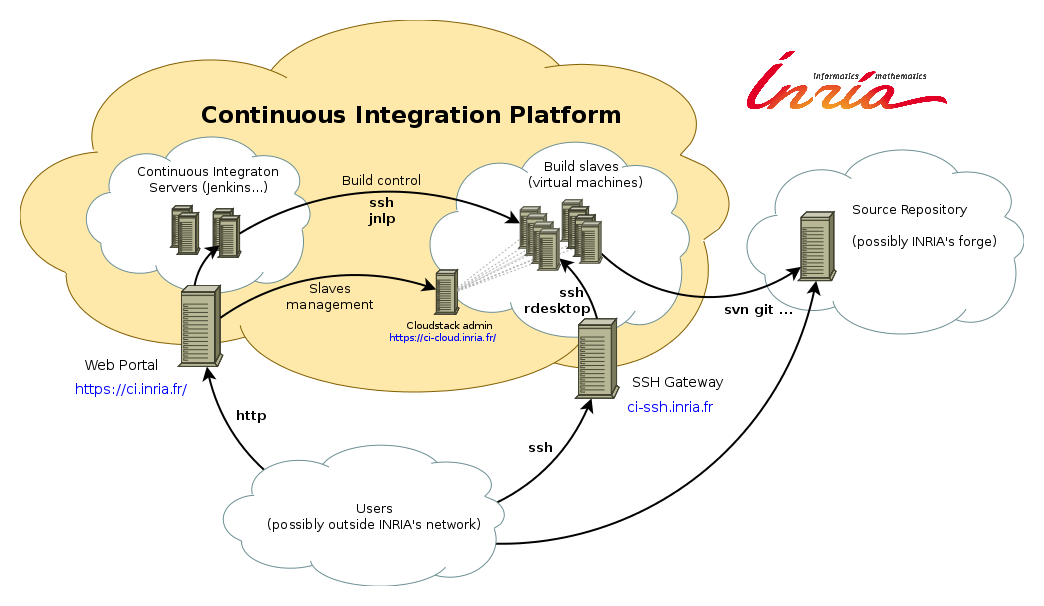Brief introduction
Continuous integration is a software development strategy that aims at improving the integration work by applying frequent quality controls. The goal is to improve the global quality of software.
This strategy leverages software testing and good development practices. Before going further, ensure you have the following conditions:
- the source code is hosted by a source code manager (Git, Mercurial, SVN, ...);
- your project can be built automatically (Makefile, Automake, CMake, Ant, Maven, ...);
- possibly, you have an automated test suite (JUnit, CppUnit, ...)
If you think that continuous integration can improve your software but you do not know how to fulfill the previous conditions, contact your local experimentation and development service (SED).
If you want to know more about continuous integration, you are seriously encouraged to read this article.
User responsibility
Because this platform is shared among all the users, you need to read the user charter and to accept it before using the service.
You are responsible for the software licenses required on the slaves (the operating system is also concerned, excepted Microsoft Windows since Inria provides users with the MSDN Academic Allicance program).
You are also responsible for anything running in the slaves of your project. Thus, you are supposed to use adequate protections (e.g. firewall or antivirus) in the slaves to avoid any problem.
How to get started?
If your project fits the requirements presented in the introduction, you can quickly use the continuous integration platform. Only one hour should be sufficent to set up your first project.
Some tutorials can help you to perform the several steps to use the platform:
- Step 1: Web Portal Tutorial → How to create your user account, your project and instantiate new slaves (the virtual machines that will actually run the jobs of your project).
- Step 1.bis (optional): CloudStack Tutorial → How to tune your virtual machines. Read this page if you have very specific needs for your virtual machines (eg. exotic operating system, more storage space, ...).
- Step 2: Slaves Access Tutorial → How to connect to your virtual machines and configure them.
- Step 3: Jenkins Tutorial → How to configure your Jenkins instance
The Jenkins tutorial covers only the most common use cases. If you want to go deeper with Jenkins, you should read the official documentation.
Finally, it is a good idea to subscribe to the following mailing-lists:
- ci-announces to receive information about the platform status and its updates
- ci-community to share your experience about continuous integration or to request help from other users.
Service offer
Inria proposes a service for continuous integrations based both on a software platform managed by DGDI and on an hardware platform managed by DSI.
Software platform
The continuous integration solution is based on Jenkins. A portal has been developed to manage the software projects. Each project runs its own Jenkins instance, thus the portal is also used to manage the interactions between a project and a Jenkins instance (e.g. the user rights management).
Hardware platform
To perform the continuous integration tasks, each Jenkins instance can access to slaves. Instead of using directly real computers, the platform leverages the virtualization capabilities and uses a cloud middleware to offer flexibility in terms of computing availability and operating system choice. For more information about the platform, see this page.

Provided templates (non exhaustive):
- Windows 10, Windows 7
- Mac OS X 10.9
- Ubuntu 18.04, CentOS 6.3, Fedora 29
Availability
Because the platform relies on an hardware part and on shared networks equipments, failures may occur. As far as we are not able to offer high availability mechanisms that ensure 24/7 running without downtime, we offer a best effort working service. Furthermore, DSI promises to deal with hardware or network problems as far as possible and a team is able to operate all the working days.
In case of problem, do not hesitate to write a mail to ci-support@inria.fr. Your request will be processed in average in a half working day.